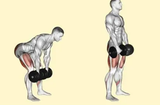Search Results
8/6/2025, 3:26:32 AM
Clinic is pretty busy today, probably can't write another reply after this one.
>>76467313
>what do I do?
Generally, yes, you gotta train to get big *however* there's a few key changes that a hypermobile person should make to their training:
> slow or very slow tempo for compound lifts.
You're not just building strength, you're trying to teach your muscles to actively control every inch of movement
> Start with a smaller ROM.
Don't bottom-out during RDLs, try first instead to only do the first 60-80% of the movement. Hypermobile people tend to only have good strength at the extremes of ROM, but not the middle. Once you master this, aboslutely got for full ROM
>focus on posterior muscles for both the his and shoulder
focus on rows, rear delts, triceps and rotator cuff for the shoulder. Hip instability cases will focus 90% on their glutes in the early stage. Literally have more meat in your butt creates a literal barrier that prevents posterior dislocation. Eventually you can add resisted hip flexion like leg raises.
>Keep an eye on your shoulder
The is a form of shoulder hypermobility that requires surgery. If you dislocate it hard enough, you can get what's called a Bankart lesion, wherein you chip off part of your glenoid (the "socket"). If you lose enough of this, no amount of muscle strength will help you might need something called a laterjet reconstruction.
In short, slow tempo and controlling the whole ROM is crucial. rows, ring rows, shrugs and side-lying external rotation will help for the shoulder, whilst light RDLs, bridges and clams are starting points for the hip. This won't reduce the hypermobility, just make it manageable.
>>76467313
>what do I do?
Generally, yes, you gotta train to get big *however* there's a few key changes that a hypermobile person should make to their training:
> slow or very slow tempo for compound lifts.
You're not just building strength, you're trying to teach your muscles to actively control every inch of movement
> Start with a smaller ROM.
Don't bottom-out during RDLs, try first instead to only do the first 60-80% of the movement. Hypermobile people tend to only have good strength at the extremes of ROM, but not the middle. Once you master this, aboslutely got for full ROM
>focus on posterior muscles for both the his and shoulder
focus on rows, rear delts, triceps and rotator cuff for the shoulder. Hip instability cases will focus 90% on their glutes in the early stage. Literally have more meat in your butt creates a literal barrier that prevents posterior dislocation. Eventually you can add resisted hip flexion like leg raises.
>Keep an eye on your shoulder
The is a form of shoulder hypermobility that requires surgery. If you dislocate it hard enough, you can get what's called a Bankart lesion, wherein you chip off part of your glenoid (the "socket"). If you lose enough of this, no amount of muscle strength will help you might need something called a laterjet reconstruction.
In short, slow tempo and controlling the whole ROM is crucial. rows, ring rows, shrugs and side-lying external rotation will help for the shoulder, whilst light RDLs, bridges and clams are starting points for the hip. This won't reduce the hypermobility, just make it manageable.
Page 1
